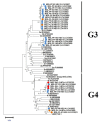Hepatitis E Virus (HEV) Spreads from Pigs and Sheep in Mongolia
- PMID: 36899748
- PMCID: PMC10000034
- DOI: 10.3390/ani13050891
Hepatitis E Virus (HEV) Spreads from Pigs and Sheep in Mongolia
Abstract
Hepatitis E is a viral infectious disease in pigs, wild boars, cows, deer, rabbits, camels, and humans as hosts caused by Paslahepevirus. Recently, it has been detected in a wide variety of animals including domestic small ruminants. Mongolia is a land of nomadic people living with livestock such as sheep, goats, and cattle. Due to how Mongolian lifestyles have changed, pork has become popular and swine diseases have emerged. Among them, Hepatitis E disease has become a zoonotic infectious disease that needs to be addressed. The HEV problem in pigs is that infected pigs excrete the virus without showing clinical symptoms and it spreads into the environment. We attempted to detect HEV RNA in sheep which had been raised in Mongolia for a long time, and those animals living together with pigs in the same region currently. We also conducted a longitudinal analysis of HEV infection in pigs in the same area and found that they were infected with HEV of the same genotype and cluster. In this study, we examined 400 feces and 120 livers (pigs and sheep) by RT-PCR in Töv Province, Mongolia. HEV detection in fecal samples was 2% (4/200) in sheep and 15% (30/200) in pigs. The results of ORF2 sequence analysis of the HEV RT-PCR-positive pigs and sheep confirmed genotype 4 in both animals. The results suggest that HEV infection is widespread in both pigs and sheep and that urgent measures to prevent infection are needed. This case study points to the changing nature of infectious diseases associated with livestock farming. It will be necessary to reconsider livestock husbandry and public health issues based on these cases.
Keywords: Mongolia; hepatitis E; phylogenetic analysis; pig; prevalence; sheep.
Conflict of interest statement
The authors declare no conflict of interest.
Figures



References
-
- Hu G.D., Ma X. Detection and Sequences Analysis of Bovine Hepatitis E Virus RNA in Xinjiang Autonomous Region. Bing Du Xue Bao. 2010;26:27–32. - PubMed
Grants and funding
LinkOut - more resources
Full Text Sources

